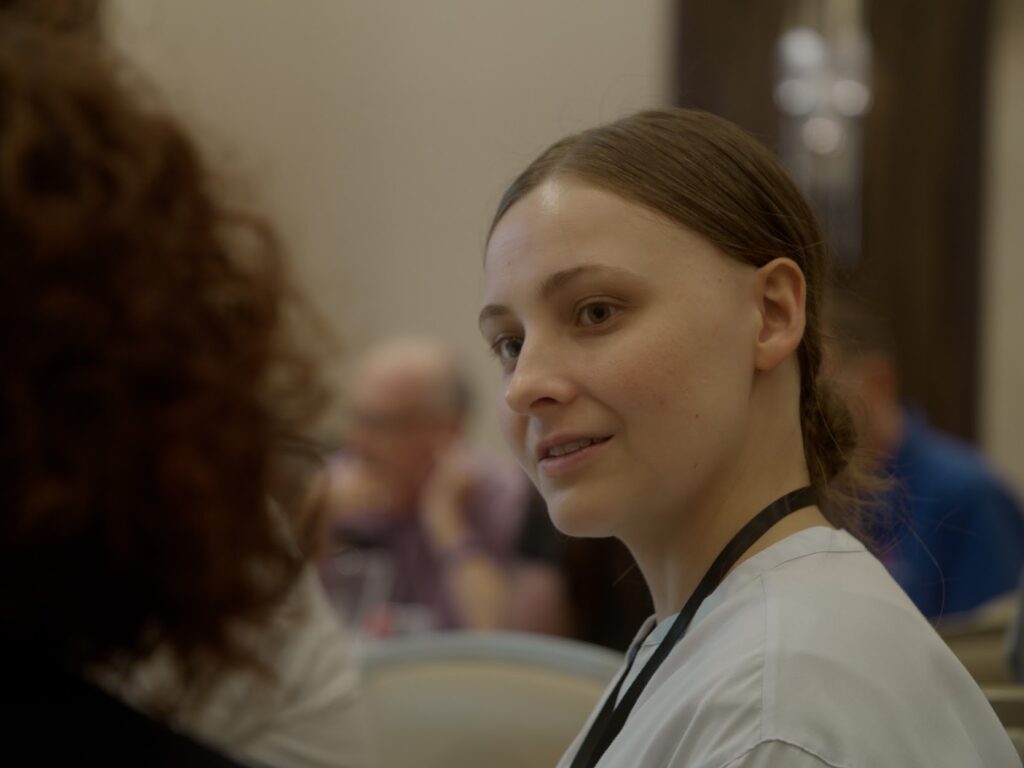September 1, 2019 / Esther Choy

Using storytelling to deepen small talk at a Leadership Story Lab training.
“So… how was your vacation?”
Summer has finally arrived in Chicago; tourists are pouring onto the magnificent miles, the museums, ballparks… everywhere. The sight of crowded downtown streets is reminding me of answering this frequently asked summer question: So, how was your vacation?
When people ask questions like this, it’s tempting to rush, thinking of our answers as just mindless small talk before we can get back to our looming deadlines, unanswered emails, and endless meetings.
But shirking “how’s it going” questions like this one might not be a good idea.
“Relationships at work matter,” writes Amy Gallo, author of HBR Guide to Managing Conflict at Work. “Getting along with your coworkers not only makes your days more pleasant but also makes you better at your job.” Gallo cites a study in which groups of friends outperformed groups of acquaintances when it came to decision-making and motor tasks.
Converting small talk questions into opportunities to tell stories will help us build those crucial connections that pay off. And that requires us to answer thoughtfully, with more than just a regurgitated list of events when someone asks about our vacation: “I went to the Wisconsin Dells. We went tubing one day. Oh, and the next day we found this great little ice cream place….” You can already see the bored expression in both the listener’s and the teller’s eyes!
Recounting events is not telling stories.
Letting others get to know us means we have to blend recounting events into a reflecting story.
Recounting events, a common feature of small talk, doesn’t show careful thought about what our experiences mean or what connects them to each other. When you hear someone recounting events, you have no theme to hang onto. You have nothing but chronology.
Telling a story involves a theme. The listener still gets to hear a sequence of events – though only a careful selection of them— attached to a theme that becomes the spine of the story.
Once More to the Lake
If you asked the beloved children’s book author E.B. White what he did during his summer vacation, he would have gone beyond small talk. Indeed, he would have had a profound answer for you. His classic personal essay Once More to the Lake is pretty much an answer to this question. And as we’d expect from the author of Charlotte’s Web, Stuart Little, E.B. White answers the question with more than just a laundry list of experiences.
Here are three things from White’s essay that apply to the brief stories that take workplace conversations beyond small talk.
1. Choose details that stick out in your mind; sacrifice the rest.
Here’s a make-or-break difference between a and actually a recounting events and actually telling a story. In recounting events, the listener has no sense that the speaker is being choosy about the details: “On our leadership retreat, we heard this speaker, and then we had a break-out session, and—oh yeah—before that, I met….” The speaker hasn’t thought about a response and is making it up as she goes along.
But in telling a story, there is a concrete and vivid detail that grabs the listener’s mind and sparks her imagination.
During E. B. White’s summer vacation, he and his son vacationed at the lakefront camp in Maine where White spent his own childhood vacations. Here are some vivid details White uses:
“I would be picking up a bait box or laying down a table fork, or I would be saying something, and suddenly it would be not I but my father who was saying the words or making the gesture.”
Those details—picking up the bait box, laying down the table fork, and the feeling that came over him when he did those things—stuck in White’s mind after the vacation.
So maybe on the retreat what impressed you most was a conversation with a colleague who sharpened his conversation skills at his local library’s book club. You find yourself reflecting on your own after-work activities and wondering if they’re shaping you on the job the way your colleague’s book club shaped him.
Next time, you may begin to answer “how was the retreat” not with a list of the sessions you attended but with the story of the book club—since that’s the detail that stood out to you.
2. Find a central idea.
What does that detail you selected symbolize? What does it mean to you?
As White watched his son, he started to get an eerie going-back-in-time feeling: “I began to sustain the illusion that he was I, and therefore, by simple transposition, that I was my father.”
That’s some deep reflection for a simple story about a quick jaunt to the lake with his son! But in this one sentence, White indicates why he is telling us this story. In returning to a place with strong childhood memories, he feels like no time has passed at all, and yet, by feeling like he has become his father, he must confront his own aging and mortality.
Now don’t get me wrong—I’m not suggesting you drop something as deep as your personal struggles with aging and mortality on your poor coworker who was just trying to be polite! But push yourself to reflect on your experiences. The central theme for your story is going to come from asking why. Why is this the detail that keeps popping up in my mind?
Think about the why and you’ll have a story that’s more compelling to listen to, more interesting to tell, and more likely to establish your work relationships on an authentic footing.
3. Blend in reflection while you share details.
Early in “Once More to the Lake,” White tells us that, as a child, when he had taken the canoe out into the lake’s early morning calm, he was “very careful never to rub my paddle against the gunwale for fear of disturbing the stillness of the cathedral.”
White is telling us why he didn’t want to make a sound. Action and reflection happen in the same sentence.
Business narratives do this, too. In a recent Fortune article, Alex Baydin, CEO of PerformLine, shared what he learned when his company almost went bankrupt. He writes: “[W]orse than all of [the] rejections [from venture capitalists] was the idea that the one thing I’d vowed to never allow as founder and CEO seemed like a serious possibility: I might miss a payroll.”
See that? Baydin could have just dumped this detail on us: “It looked like I was going to miss a payroll.” But instead, he blends in what it meant to him not to be able to pay his employees. He has reflected on his experience, and the reader can tell! We can see Baydin’s values as he relates this unsettling detail.
So next time you hear the question, “so how was your vacation,” or “how did the conference go,” resist the temptation to default to recounting events. Instead, select an important detail, find a central idea about your experience, and finally blend in reflection with that detail. Then, watch how your professional relationships with your colleagues, managers and clients grow organically!
Related Articles
Tired of Small Talk? Start Story Collecting
Your Storytelling Holiday Survival Guide
If you need help telling your story, contact us for a complimentary consultation session! And sign up for our Monthly Guide to Better Storytelling. It’s packed with information on free events, tips and coaching sessions.
Better Every Story
"This is an amazing and insightful post! I hadn’t thought of that so you broadened my perspective. I always appreciate your insight!" - Dan B.
Join the thousands who receive Esther Choy’s insights, best practices and examples of great storytelling in our twice monthly newsletter.


